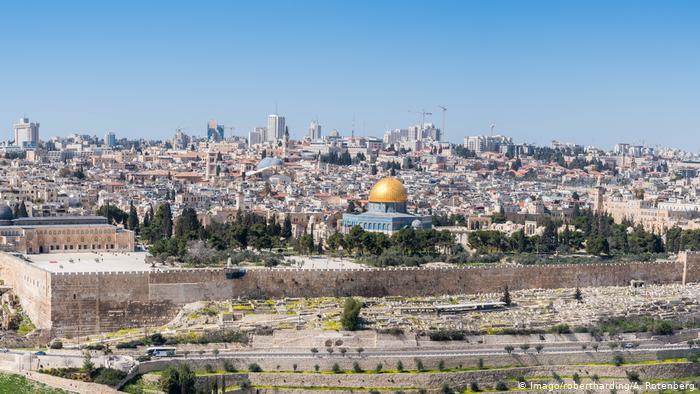Some call it the city of conflicts. Founded 3000 BC, Jerusalem is one of the oldest cities in the world. Located in Western Asia, on a plateau in the Judaean Mountains between the Mediterranean and the Dead Sea, Jerusalem is more than 5,0000 years old.
Three major Abrahamic religions consider Jerusalem a holy place. Those are Christianity, Islam, and Judaism.
Over the course of history, Jerusalem has seen its fair share of conflicts, battles, different rulers, and so on. Let’s take a look at the complex history of the city. That might help you understand the importance of the city for different religions and nations.
City of David
According to the Hebrew Bible, King David established the monarchy in Jerusalem. The Hebrew Bible also states that descendants of King David include the messiah.
David, the King of the Kingdoms of Judea and Israel, conquered the city 1,000 years BC. He moved the center of his government to the city, making it capital and religious center of the kingdom.
![]()
The Bible also states that Solomon, David’s son, built the first temple in the city. That is how Jerusalem also becomes center of the Judaism.
Under Persian rule
King Nebuchadnezzar II conquered Jerusalem in 597 BC. He captured the current king and members of the high class and sent them to Babylon. Then, he destroyed the temple in Jerusalem.
Nebuchadnezzar II is considered King of Babylon and the longest-reigning monarch of the Neo-Babylonian Empire.
His conquest of Judah is described in the Bible’s Books of Kings. To this day, Babylon, the capital of his kingdom, remains the largest archeological site in the Middle East. The Bible also identifies as the king responsible for destroying Solomon’s temple and initiating the Babylonian captivity.
Roman and Byzantium Governance
Jerusalem falls under Roman occupation in 63 CE. Between 66 and 135 CE, there are a series of revolts by the Jews, classified as the Jewish-Roman wars.
During these wars, the temple in the city gets destroyed as well. Romans and Byzantines governed the city for more than 600 years.
![]()
The Jewish-Roman wars had a dramatic impact on Jews in general. The wars turned Jewish people from a major population in the Eastern Mediterranean into a scattered minority. To this day, historians cite the war as a disaster to Jewish society.
The events in the wars also had a major impact on Judaism, as the central worship site of Second Temple Judaism was destroyed by Titus in 70 CE.
Arab conquest
Following the conquest of Syria, Muslim armies make it to Palestine as well. Omar, or sometimes spelled Umar, was one of the most powerful and influential Muslim caliphs in history. Under his command, Muslim forces take Jerusalem in 637. For the next several years, different Muslim rulers control the city.
Under Omar, his caliphate expanded, ruling the Sasanian Empire and more than two-thirds of the Byzantine Empire.
Omar is important for another reason as well. He set aside the Christian ban on Jews and allowed them into Jerusalem and to worship.
The Crusaders
By 1070, Muslim rulers grow into a bigger and bigger threat to Christianity. This prompts Pope Urban II to call for a crusade. In total, there are five Crusades in span of 20 years.
The Siege of Jerusalem by the forces of the First Crusade resulted in capture of the city from Fatimid Caliphate. This laid the foundations for the Christian Kingdom of Jerusalem which lasted for almost a century.
Crusaders finally lose the control of the city by 1244, when it goes under Muslim governance once again. The Christian Kingdom of Jerusalem resulted in mass slaughter of thousands of Muslims and Jews. It also led to conversion of Muslim holy sites on the Temple Mount into Christian shrines.
Ottoman Jerusalem
Following its conquest on Egypt and Arabia, Ottomans capture Jerusalem as well. They turn it into the administrative center for the Ottoman administrative region in 1535. The city flourished within the first decades of Ottoman rule.
The Ottoman Empire ruled the city from about 1516 to 1917.
![]()
The British Rule
After World War I, Great Britain took over Jerusalem. At the time, it was part of Palestine. The British controlled the city and the surrounding region until after World War II.
Following World War I and the fall of the Ottoman Empire, the British Balfour Declaration promised the establishment of a Jewish national home in Ottoman-controlled Palestine.
The British also promised the Arabs that a United Arab country, covering most of the Arab Middle East, would result if the Ottoman Turks were defeated. However, following the end of the war, neither promise was delivered.
Divided city
After World War II, Great Britain withdraws from their Palestine control and rule. United Nations vote for partition of the country, making way for survivors of the Holocaust. The British Army found itself stuck in the middle of a growing conflict between Arabs and Jews in Palestine.
The Holocaust had a major effect on the situation in Palestine. During WWII, the British restricted the entry into Palestine of European Jews escaping Nazi persecution. Because they wanted to please the Egyptians and oil-rich Saudis, the British imposed a limit on Jewish immigration.
This provoked armed Jewish resistance, and eventually united those who looked to Britain to help establish their national homeland.
In November 1947, The United Nations recommended partition of Palestine and the establishment of separate Arab and Jewish states. In May 1948, British forces departed from Palestine, leaving the Jews and the Arabs to fight out in the war that followed. The UN Partition Plan for Palestine in 1947 recommended the creation of independent Arab and Jewish states and an internationalized Jerusalem.
The Jewish Agency accepted the plan, but Arab leaders rejected it.
In 1948, the Jewish Agency declared the independence of the State of Israel, resulting in the 1948 Arab-Israeli War. This saw Israel’s establishment over most of the former Mandate territory.
Gaza Strip and West Bank remained under control of neighboring Arab states.
Israel conquers East Jerusalem
In 1967, the six-day war broke out between Israel and Arab states. On the Arab side, Jordan, Syria, and Egypt fought against Israel.
The brief but bloody conflict ended with a UN brokered ceasefire. What resulted was a significantly altered map of the Mideast. It gave rise to lingering geopolitical friction.
![]()
Following the war, Israel captured the Sinai Peninsula, the Golan Heights, the Gaza Strip, and the West Bank. That also includes East Jerusalem.
Status Quo Divided Territory
Israel allows Muslim entrance to Holy sites in Jerusalem. For example, the Old City is under Israeli control, but the Al-Aqsa mosque remains under the administration of the Islamic Waqf. Israeli security forces remain active on the site and coordinate their actions with Waqf. Both Jews and Christians can visit the site, but they cannot pray on the land (something Muslim can).
In 1988, Jordan withdraws from its right on the West Coast and East Jerusalem. That led to the declaration of the country Palestine. The country considers Jerusalem under its territory and their capital.





















